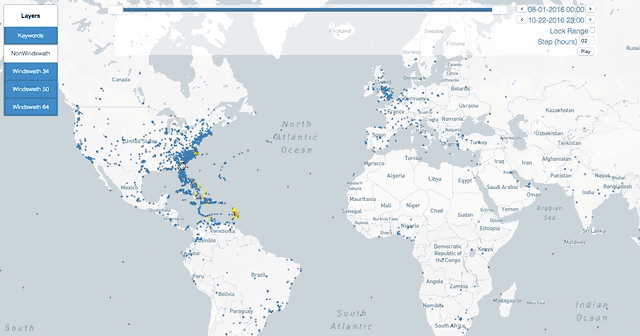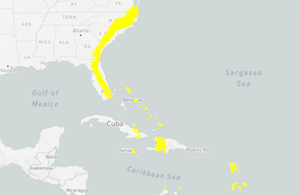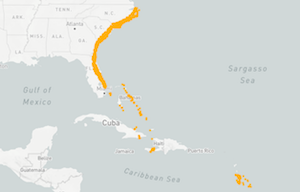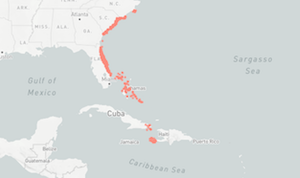Interactive Tweet Map
Link to Interactive Map:(/matthew-tweetmap)
Clicking a layer on the left-hand side of the map will turn the layer on or off. If you zoom into the map far enough (scroll to zoom), individual tweets become clickable and you can then view the user, tweet text, and time it was posted.

The slider at the top covers the entire time of the collection and can be adjusted to show only tweets posted during specific times. If you set the window and press play, you can watch the storm make landfall and even see the density of the tweets with matthew-related keywords move with the path of the storm.

The keyword tweets will always appear on top of the other tweets. Adjusting the time slider for during storm times and toggling the keyword tweets will show areas of high keyword activity in comparison to general areas with geotagged tweets. Many of these keyword tweets contain clickable links to storm-related information

This map separates the geo-located tweets into the following five categories:
| Layer | Description |
|---|---|
| Keywords | Tweets collected through the keyword search collection (keywords listed below) which include a geo-tag. This collection ran from September 25, 2016 to October 22, 2016. |
| NonWindswath | Any geo-located tweet found in the following bounding box (on landmasses) which do not fall within the path of the storm. These tweets were collected between August 1, 2016 and October 22, 2016  |
| Windswath 34 | Any geo-located tweet between August 1, 2016 and October 22, 2016 that lands within the 34mph radii of the storm path. |
| Windswath 50 | Any geo-located tweet between August 1, 2016 and October 22, 2016 that lands within the 50mph radii of the storm path. |
| Windswath 64 | Any geo-located tweet between August 1, 2016 and October 22, 2016 that lands within the 64mph radii of the storm path. |
Collection Results
| Collection | Total Tweets | Geotagged Tweets | Comments |
|---|---|---|---|
| Keyword | 13,830,252 | 36,618 | This number is very low, only 0.2% as opposed to the standard 1-2%. |
| All Geotagged (In Windswath) | 3,434,483 | 1,017,795 | Only 29% of the data returned from GNIP has an exact geotag. |
| All Geotagged (Non-Windswath) | 6,563,545 | 2,264,231 | Same problem here (only about 34% of the collected geo tweets are actually geotagged) |
While we still do have millions of results here, the geotagged collection is a bit misleading. Tweets are no longer exclusively geotagged by the lat/lon of the posting device, but rather can be geolocated by a region. Consider the following tweet:

'location': {'country_code': 'United States',
'displayName': 'Deltona, FL',
'geo': {'coordinates': [[[-81.285896, 28.84511],
[-81.285896, 28.964071],
[-81.154121, 28.964071],
[-81.154121, 28.84511]]],
'type': 'Polygon'},
The user chose to post it from Deltona, FL, which is then embedded into the tweet as a Polygon outline of the region of Deltona. Since Deltona is within the collection area, this tweet is returned by the query, but we can only have the city-level granularity for placing it on a map.
TODO: This is not an impossible problem to solve and the solution could certainly be useful, especially for the keyword collection. We will have to reverse the location field from these tweets and aggregate at the city level. This could enrich the keyword collection dramatically, though does not help with movement derivation or any hyperlocalized analysis.
The keyword collection ran from Sep 25 to Oct 22, 2016 on these values:
'hurricane OR ouragan',
'siklón',
'haiti',
'hurricanematthew OR matthew',
'ouraganmathieu OR mathieu',
'matthewhaiti',
'(matye ayiti) OR matyeayiti',
'port salut',
'les cayes',
'jeremie OR jérémie',
'(pray for haiti) OR prayforhaiti OR pray4haiti',
'jeremie OR jérémie',
'(tiburon penninsula) OR tiburonpenninsula OR (península de tiburón)',
'bahamas OR jamaica OR cuba',
'(pray for florida) OR prayforflorida OR pray4florida',
'flwx OR ncwx OR scwx OR gawx OR vawx',
'invest97l'
This work is a collaboration among the following groups: